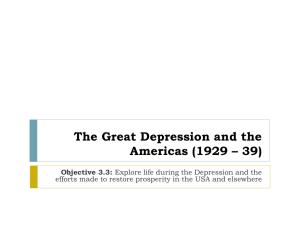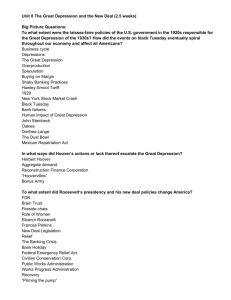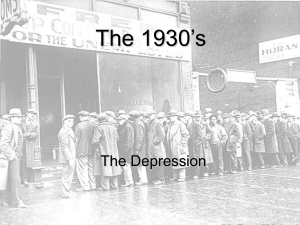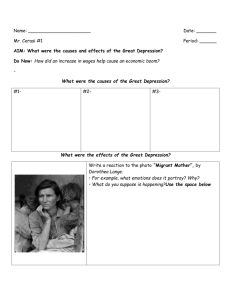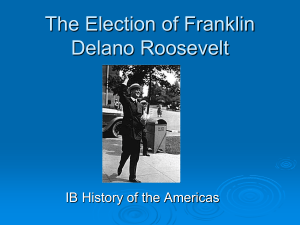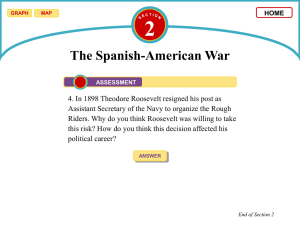20s &30s Key Terms Review - Conneaut Area City Schools
advertisement
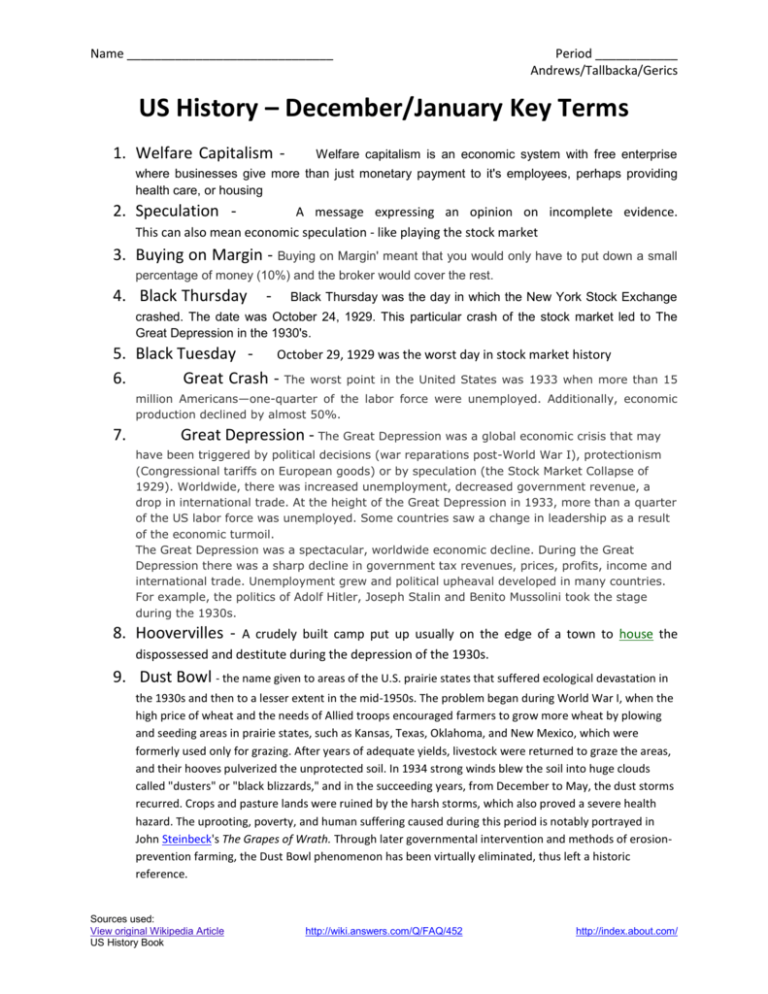
Name ______________________________ Period ____________ Andrews/Tallbacka/Gerics US History – December/January Key Terms 1. Welfare Capitalism - Welfare capitalism is an economic system with free enterprise where businesses give more than just monetary payment to it's employees, perhaps providing health care, or housing 2. Speculation - A message expressing an opinion on incomplete evidence. This can also mean economic speculation - like playing the stock market 3. Buying on Margin - Buying on Margin' meant that you would only have to put down a small percentage of money (10%) and the broker would cover the rest. 4. Black Thursday - Black Thursday was the day in which the New York Stock Exchange crashed. The date was October 24, 1929. This particular crash of the stock market led to The Great Depression in the 1930's. 5. Black Tuesday - October 29, 1929 was the worst day in stock market history 6. Great Crash - The worst point in the United States was 1933 when more than 15 million Americans—one-quarter of the labor force were unemployed. Additionally, economic production declined by almost 50%. 7. Great Depression - The Great Depression was a global economic crisis that may have been triggered by political decisions (war reparations post-World War I), protectionism (Congressional tariffs on European goods) or by speculation (the Stock Market Collapse of 1929). Worldwide, there was increased unemployment, decreased government revenue, a drop in international trade. At the height of the Great Depression in 1933, more than a quarter of the US labor force was unemployed. Some countries saw a change in leadership as a result of the economic turmoil. The Great Depression was a spectacular, worldwide economic decline. During the Great Depression there was a sharp decline in government tax revenues, prices, profits, income and international trade. Unemployment grew and political upheaval developed in many countries. For example, the politics of Adolf Hitler, Joseph Stalin and Benito Mussolini took the stage during the 1930s. 8. Hoovervilles - A crudely built camp put up usually on the edge of a town to house the dispossessed and destitute during the depression of the 1930s. 9. Dust Bowl - the name given to areas of the U.S. prairie states that suffered ecological devastation in the 1930s and then to a lesser extent in the mid-1950s. The problem began during World War I, when the high price of wheat and the needs of Allied troops encouraged farmers to grow more wheat by plowing and seeding areas in prairie states, such as Kansas, Texas, Oklahoma, and New Mexico, which were formerly used only for grazing. After years of adequate yields, livestock were returned to graze the areas, and their hooves pulverized the unprotected soil. In 1934 strong winds blew the soil into huge clouds called "dusters" or "black blizzards," and in the succeeding years, from December to May, the dust storms recurred. Crops and pasture lands were ruined by the harsh storms, which also proved a severe health hazard. The uprooting, poverty, and human suffering caused during this period is notably portrayed in John Steinbeck's The Grapes of Wrath. Through later governmental intervention and methods of erosionprevention farming, the Dust Bowl phenomenon has been virtually eliminated, thus left a historic reference. Sources used: View original Wikipedia Article US History Book http://wiki.answers.com/Q/FAQ/452 http://index.about.com/ Name ______________________________ 10. Period ____________ Andrews/Tallbacka/Gerics 21st Amendment to The United States Constitution - The only constitutional amendment ratified by the electorate rather than legislators, the Twenty‐first was also the only amendment to repeal another, the Eighteenth. Not quite fourteen years elapsed between the adoption of the national prohibition amendment on 16 January 1919, and the ratification of the Twenty‐first Amendment on 5 December 1933. National prohibition sharply reduced but did not altogether eliminate the use of alcoholic beverages in the United States. Neither state and local law enforcement officials nor the small federal Prohibition Bureau authorized by the 1919 Volstead Act could cope with the variety and volume of prohibition violations. The longer sentences and larger fines imposed by the 1929 federal Jones “Five‐and Ten” Act had little effect. Nor did a series of Supreme Court decisions upholding concurrent powers of state and federal enforcement, United States v. Lanza (1922); warrantless automobile searches, Carroll v. United States (1925); restrictions on medicinal liquor prescriptions, Lambert v. Yellowley (1926); and wiretap telephone surveillance Olmstead v. United States (1928). Opposition to prohibition came from politically active groups of recent immigrants who saw prohibition as a slap at their cultures and antiprohibition organizations, which argued that the liquor ban encouraged crime and disrespect for all law, while simultaneously giving the federal government too much power over people's personal lives. The economic collapse of the early 1930s brought arguments that prohibition took away jobs and liquor taxes. The Democratic party endorsed prohibition repeal in 1932, and its sweeping November victory brought quick congressional action. On 20 February 1933, Congress adopted, by more than the required two‐thirds, an amendment resolution that would repeal the Eighteenth Amendment and prohibit transportation of intoxicating beverages into any U.S. state, territory, or possession in violation of its laws. The resolution also called for ratification of the proposed amendment by state conventions rather than legislatures. The Supreme Court in Hawke v. Smith (1920), overturning a 1919 Ohio referendum on the Eighteenth Amendment, had stirred demands that this never‐employed alternative Article V procedure be used so that convention delegate elections would provide a direct expression of popular opinion on the proposed constitutional amendment. During 1933 thirty‐eight states held delegate elections: 73 percent of 21 million voters cast ballots for candidates who favored an end to national prohibition, and only South Carolina voters rejected repeal. Ratification conventions quickly certified the results, and on 5 December 1933, when Pennsylvania, Ohio, and finally Utah acted, national prohibition came to an end. Despite the fact that alcohol consumption rates remained below pre‐1920 levels for forty years after national prohibition, the federal effort to forbid adult use of alcohol has been generally perceived as a failure, a futile policy, and a misapplication of the constitutional amending process. 11. Empire State Building - is on the west side of Fifth Avenue between Thirty-third and Thirtyfourth Streets in New York City, the site of the original Waldorf Astoria Hotel. In the center of Manhattan Island, it is roughly equidistant from the East and Hudson Rivers and the northern and southern tips of Manhattan. The building's 102 stories rise 1,250 feet, and the tower adds 222 feet for a total height of 1,472 feet. Primarily an office building, it has retail shops on the ground floor and observation facilities on the 86th and 102d floors. The building was designed by Shreve, Lamb and Harmon. The financier John J. Raskob and the former New York governor Alfred E. Smith built it between 1929 and 1931. The building company of Starrett Brothers and Eken, Inc., managed the construction. Conceived during the prosperous 1920s, the Empire State Building was intended to be the largest and most prestigious office building in New York. Originally estimated to cost $50 million, it actually cost only $24.7 million (approximately $500 million in year 2000 dollars). For forty years the Empire State Building was the tallest office building in the world, and its prominence made it a symbol of New York City. Designated a National Historic Landmark, the building has been renovated regularly for modern convenience and continued to attract prestigious tenants in the twenty-first century Sources used: View original Wikipedia Article US History Book http://wiki.answers.com/Q/FAQ/452 http://index.about.com/ Name ______________________________ 12. Period ____________ Andrews/Tallbacka/Gerics Herbert Hoover – (born Aug. 10, 1874, West Branch, Iowa, U.S.died Oct. 20, 1964, New York, N.Y.) 31st president of the U.S. (192933). After graduating from Stanford University (1895), he became a mining engineer, administering engineering projects on four continents (18951913). He then headed Allied relief operations in England and Belgium. As U.S. national food administrator during World War I, he instituted programs that furnished food to the Allies and to famine-stricken areas of Europe. Appointed U.S. secretary of commerce (1921-27), he reorganized the department, creating divisions to regulate broadcasting and aviation. He oversaw commissions to build Boulder (later Hoover) Dam and the St. Lawrence Seaway. In 1928, as the Republican presidential candidate, he soundly defeated Alfred E. Smith. His hopes for a New Day program were quickly overwhelmed by the Great Depression. In response, he called business leaders to the White House to urge them not to lay off workers or cut wages, and he urged state and local governments to join private charities in caring for destitute Americans. Believing that a dole would sap the will of Americans to provide for themselves, he adamantly opposed direct federal relief payments to individuals, though in 1932 he finally allowed relief to farmers through the Reconstruction Finance Corp. After his electoral defeat in 1932 by Franklin D. Roosevelt, he regularly spoke out against what he considered the radicalism of the New Deal and Roosevelt's attempts to involve the U.S. in countering German and Japanese aggression. After World War II he participated in famine-relief work in Europe and was appointed head of the Hoover Commission 13. Hawley-Smoot Tariff - The Tariff Act of 1930 (codified at 19 U.S.C. ch.4 ), otherwise known as the Smoot-Hawley Tariff or Hawley-Smoot Tariff, was an act, sponsored by SenatorReed Smoot and RepresentativeWillis C. Hawley, and signed into law on June 17, 1930, that raised U.S.tariffs on over 20,000 imported goods to record levels. The overall level tariffs under the Tariff were the second-highest in U.S. history, exceeded by a small margin only by the Tariff of 1828.[3] The act, and the ensuing retaliatory tariffs by U.S. trading partners, reduced American exports and imports by more than half. 14. Bonus Army - World War I veterans who gathered in Washington, D.C., in summer 1932 to demand payment of their promised bonuses. More than 12,000 veterans and their families camped near the U.S. Capitol, urging support for a bill to force early payment of bonuses already voted by Congress. When the bill was defeated, most of the crowd returned home, but some angry protests caused local authorities to ask Pres. Herbert Hoover for federal assistance. Army troops led by Gen. Douglas MacArthur drove out the protesters and burned their camps. The resulting public outcry was a factor in Hoover's defeat in the 1932 election. Another group of veterans gathered in 1933, but Congress again rejected bonus legislation. In 1936 Congress finally enacted a bill that paid nearly $2 billion in veterans' benefits 15. Franklin Delano Roosevelt - (born Jan. 30, 1882, Hyde Park, N.Y., U.S.died April 12, 1945, Warm Springs, Ga.) 32nd president of the U.S. (1933-45). Attracted to politics by the example of his cousin Theodore Roosevelt, he became active in the Democratic Party. In 1905 he married Eleanor Roosevelt, who would become a valued adviser in future years. He served in the New York senate Sources used: View original Wikipedia Article US History Book http://wiki.answers.com/Q/FAQ/452 http://index.about.com/ Name ______________________________ Period ____________ Andrews/Tallbacka/Gerics (191013) and as U.S. assistant secretary of the navy (191320). In 1920 he was nominated by the Democrats as their vice presidential candidate. The next year he was stricken with polio; though unable to walk, he remained active in politics. As governor of New York (192933), he set up the first state relief agency in the U.S. In 1932 he won the Democratic presidential nomination with the help of James Farley and easily defeated Pres. Herbert Hoover. In his inaugural address to a nation of more than 13 million unemployed, he pronounced that the only thing we have to fear is fear itself. Congress passed most of the changes he sought in his New Deal program in the first hundred days of his term. He was overwhelmingly reelected in 1936 over Alf Landon. To solve legal challenges to the New Deal, he proposed enlarging the Supreme Court, but his court-packing plan aroused strong opposition and had to be abandoned. By the late 1930s economic recovery had slowed, but Roosevelt was increasingly concerned with the growing threat of war. In 1940 he was reelected to an unprecedented third term, defeating Wendell Willkie. He developed the lend-lease program to aid U.S. allies, especially Britain, in the early years of World War II. In 1941 he met with Winston Churchill to draft the Atlantic Charter. With U.S. entry into war, Roosevelt mobilized industry for military production and formed an alliance with Britain and the Soviet Union; he met with Churchill and Joseph Stalin to form war policy at Tehrn (1943) and Yalta (1945). Despite declining health, he won reelection for a fourth term against Thomas Dewey (1944) but served only briefly before his death or / and - (1882-1945) 32nd president of the United States. Born to a wealthy upstate New York family, Roosevelt was raised to a life of privilege. After graduating from Harvard and attending Columbia Law School, he practiced law and ran successfully for the state Senate in 1910. Although he won reelection easily in 1912, he left Albany in 1913 to become assistant secretary of the navy, in which position he advocated preparedness for World War I. He left the navy post in 1920 to make an unsuccessful run for the vice presidency, with James M. Cox at the head of the ticket. A crippling attack of polio in 1921 led him to spend the next several years searching in vain for some treatment that would enable him to regain use of his legs. He returned to public life in 1928 with a successful run for the governorship of New York, where he developed modest programs to help combat the devastation of the Depression and began to call for federal efforts to combat the economic ruin facing the country. In 1932, having won a huge reelection victory in 1930, he took the Democratic nomination for president on the fourth ballot, pledging “a New Deal” for the country. He defeated Herbert Hoover by a comfortable margin and immediately began a remarkable campaign to rebuild the U.S. economy by creating numerous federal agencies that would offer employment opportunities to those out of work while providing economic support to those who could not work. These and other programs enjoyed varying degrees of success, but they began to change the nation's despairing mood. A second round of legislative initiatives, in 1935, dubbed the “Second New Deal, ” produced profound and sometimes permanent changes in the government's role in America's social patterns. As World War II threatened the world's security, he also gradually moved the nation from its postwar isolationism to more active support of Great Britain, in particular, winning congressional approval for Lend-Lease in 1940, which allowed him to provide Britain with arms without receiving payment for them; in 1941 he and British Prime Minister Winston Churchill signed the Atlantic Charter, in which they condemned fascism and called for national self-determination. Later that year, he extended Lend-Lease to cover Russia. After Japan bombed Pearl Harbor, on December 7, 1941, which Roosevelt called “a date which will live in infamy, ” the United States faced a two-front war; Roosevelt decided to concentrate on the war in Europe first. By 1943, the tide of the war seemed to have finally turned. In a series of summit meetings, Roosevelt, Churchill, and Josef Stalin negotiated plans for a long-planned Allied invasion of France's channel coast; the invasion was finally launched on June 6, 1944, D-Day. Roosevelt easily won reelection to a fourth term in 1944; at a final summit, at Yalta, in the Crimea, in January 1945, he appeared frail and ill but vigorously participated in planning for a postwar Europe, although a real accord was reached only on division of Germany. He died of a cerebral hemorrhage at Warm Springs, Georgia, in April. 16. New Deal – The set of programs and policies designed to promote economic recovery and social reform introduced during the 1930s by President Franklin D. Roosevelt. During the period of FDR when these programs and policies were developed. U.S. domestic program of President Franklin Roosevelt to bring economic relief during the Great Depression (1933-39). The term was taken from Roosevelt's speech accepting the 1932 presidential nomination, in which he promised a new deal for the American people. New Deal legislation was enacted mainly in the first three months of 1933 (Roosevelt's hundred Sources used: View original Wikipedia Article US History Book http://wiki.answers.com/Q/FAQ/452 http://index.about.com/ Name ______________________________ Period ____________ Andrews/Tallbacka/Gerics days) and established such agencies as the Civil Works Administration and the Civilian Conservation Corps to alleviate unemployment, the National Recovery Administration to revive industrial production, the Federal Deposit Insurance Corp. and the Securities and Exchange Commission to regulate financial institutions, the Agricultural Adjustment Administration to support farm production, and the Tennessee Valley Authority to provide public power and flood control. A second period of legislation (193536), often called the second New Deal, established the National Labor Relations Board, the Works Progress Administration, and the social security system. Some legislation was declared unconstitutional by the U.S. Supreme Court, and some programs did not accomplish their aims, but many reforms were continued by later administrations and permanently changed the role of government. Public Works Administration 17. First Hundred Days - The first hundred days is a sample of the first 100 days of a first term presidency of a president of the United States. It is used to measure the successes and accomplishments of a president during the time that their power and influence is at its greatest. The term was coined in a July 24, 1933, radio address by U.S. President Franklin D. Roosevelt, although he was referring to the 100 day session of the 73rd United States Congress between March 9 and June 17, rather than the first 100 days of his administration 18. Federal Deposit Insurance Corporation (FDIC) abbr. – Type: Government Agency On the web: http://www.fdic.gov The FDIC is like money in the bank, only better. The Federal Insurance Corporation (FDIC) insures deposits and retirement accounts in member accounts for up to $250,000, protecting depositors in the event of bank failure. It also supervises financial institutions and manages failed banks. The FDIC is funded by member bank premiums for deposit insurance coverage and from earnings on investments in US Treasury securities. It insures more than $9 trillion of deposits, covering virtually every bank in the country. (It does not cover mutual funds, securities, or related investments.) An independent federal agency, the FDIC was created in 1933 in response to bank runs during the Great Depression. 19. Public Works Programs - Created the - Public Works Administration (PWA), in U.S. history, New Deal government agency established (1933) by the Congress as the Federal Administration of Public Works, pursuant to the National Industrial Recovery Act. In the hope of promoting and stabilizing employment and purchasing power, President Franklin Delano Roosevelt brought about the creation of this agency to administer the construction of various public works, such as public buildings, bridges, dams, and housing developments, and to make loans to states and municipalities for similar projects. Subsequent legislation continued its operation; under the administration (1933-39) of Harold L. Ickes, the PWA completed a great many public projects. President Roosevelt's reorganization plan of 1939 made the PWA a division of the Federal Works Agency. The PWA was liquidated in the 1940s 20. Tennessee Valley Authority - U.S. government agencies established in 1933 to control floods, improve navigation, and generate electrical power along the Tennessee River and its tributaries. The TVA is a public corporation governed by a board of directors. It has Sources used: View original Wikipedia Article US History Book http://wiki.answers.com/Q/FAQ/452 http://index.about.com/ Name ______________________________ Period ____________ Andrews/Tallbacka/Gerics jurisdiction over the entire basin of the river, which covers parts of seven states: Alabama, Georgia, Kentucky, Mississippi, North Carolina, Tennessee, and Virginia. Created by Congress as one of the major public-works projects of the New Deal, the TVA built a system of dams to control the region's chronic flooding, deepened the channel to improve navigation, and encouraged the development of port facilities along the river. The projects greatly increased traffic on the river and provided cheap electricity, spurring the industrial development of what had been a chronically depressed regional economy. Public Works Administration 18. Eleanor Roosevelt - 1884–1962), first lady, diplomat, journalist, and activistEleanor Roosevelt struggled to reconcile an intense abhorrence of war with a realpolitik commitment against totalitarianism. This caused her to weigh deeply held but often conflicting beliefs. In World War I, as wife of Assistant Secretary of the Navy Franklin D. Roosevelt, she worked with shell‐shocked sailors at St. Elizabeth's Hospital and the American Red Cross Canteen, and this introduced her to some of the ravages of war. Later she joined the Women's International League for Peace and Freedom and chaired the Bok Peace Prize Committee. Her second monograph, This Troubled World, was a plea for economic deterrence instead of war. However, by late 1939, Adolf Hitler's actions led her to support U.S. military intervention in World War II. As the wife of the president, she urged women to enlist and join defense industries, corresponded with hundreds of military personnel, and used her daily newspaper column to defend the war effort while supporting civil liberties at home. She was a strong critic of Japanese American internment and the administration's policy of limiting the acceptance of refugees, and publicly supported those conscientious objectors who chose medical service and jail over enlistment. After her husband's death in office in April 1945, as the European War ended, the former first lady urged full employment, a comprehensive veterans benefit package, and a strong United Nations. She supported the atomic bombing of Hiroshima but was silent about Nagasaki. Appointed a UN delegate by President Harry S. Truman, she orchestrated support for the Universal Declaration of Human Rights and oversaw refugee policy. Opposing Truman, she urged early recognition of Israel and UN oversight of the Marshall Plan, and only reluctantly supported the creation of NATO. As the Cold War intensified in the 1950s, she supported an economic rather than a military emphasis on containment, and in the 1960s, she opposed U.S. military involvement in Vietnam and lobbied against the stockpiling of nuclear weapons. She died still convinced that effective democracy was the most effective deterrence to both communism and war. 19. Second New Deal - The Second New Deal is the term used by commentators at the [1] time and historians ever since to characterize the second stage of the New Deal programs of President Franklin D. Roosevelt. In his address to Congress in January 1935, Roosevelt called for three major goals: improved use of national resources, security against old age, unemployment and illness, and slum clearance, as well as a national welfare program (the WPA) to replace state relief efforts. It is usually dated 1935-36, and includes programs to redistribute wealth, income and power in favor of the poor, the old, farmers and labor unions. The most important programs included Social Security, the National Labor Relations Act ("Wagner Act"), the Banking Act, rural electrification, and breaking up utility holding companies. Programs that were later ended by the Supreme Court or the Conservative Coalition included WPA, NYA, the Resettlement Administration, and programs for retail price control, farm rescues, coal stabilization, and taxes on the rich and the Undistributed profits tax. Liberals in Congress passed the Bonus Bill of $1.5 billion to 3 million World War veterans over FDR's veto. Liberals strongly supported the new direction, and formed the New Deal Coalition of union members, big city machines, the white South, and ethnic minorities to support it; and conservatives—typified by the American Liberty League were strongly opposed. Sources used: View original Wikipedia Article US History Book http://wiki.answers.com/Q/FAQ/452 http://index.about.com/ Name ______________________________ 20. Period ____________ Andrews/Tallbacka/Gerics Wagner Act – 1935) Labour legislation passed by the U.S. Congress. Sponsored by Sen. Robert F. Wagner, the act protected workers' rights to form unions and to bargain collectively. A three-member National Labor Relations Board was established to protect against unfair labor practices; it could order elections to allow workers to choose which union they wanted to represent them. The act also prohibited employers from engaging in unfair labor practices such as setting up a company union and firing or otherwise discriminating against workers who organized or joined unions. The act, considered the most important piece of labor legislation in the 20th century, helped ensure union support for Pres. Franklin D. Roosevelt in the 1936 election. 21. Social Security System - A United States federal program of social insurance and benefits developed in 1935. The Social Security program's benefits include retirement income, disability income, Medicare and Medicaid, and death and survivorship benefits. Social Security is one of the largest government programs in the world, paying out hundreds of billions of dollars per year. Based on the year someone was born, retirement benefits may begin as early as age 62 and as late as age 67. The amount of income received is based on the average wages earned over the worker's lifetime, with a maximum calculable amount of $102,000 as of 2008. Spouses are also eligible to receive Social Security benefits, even if they have limited or non-existent work histories. Investopedia Says: The original program was part of President Franklin D. Roosevelt's New Deal plan to lift the U.S. out of the Great Depression. Today, the program is funded through payroll taxes collected by employees and companies; monies are placed into the Social Security Trust Fund and payments are managed by the government along with the Federal Reserve Board. Social Security has faced serious solvency issues for many decades; today's payments are made from current payroll contributions by workers who may not have money available for them when they retire. Social security reform, whether through legislation, tax law changes, or privatization, has been a major political issue that draws strong opinions from different demographic segments. Social Security faces the real threat of becoming insolvent because of factors such as longer life expectancies, a large baby boomer population currently entering retirement age, and inflation. Questions to Consider… When Was The Great Depression? In the United States, the Great Depression is associated with Black Tuesday, the stock market crash of 29 October 1929, although the country entered a recession months before the crash. Herbert Hoover was then President of the United States. The Depression continued until the onset of World War II, with Franklin D. Roosevelt following Hoover as president. Possible Cause: World War I M.A.I.N The United States entered World War I late (1917) and emerged as a major creditor and financier of post-War restoration. Germany was burdened with massive war reparations (a political decision on the part of the victors, see the Treaty of Versailles). Britain and France needed to rebuild. US banks were more than willing to loan money. However, once US banks began failing ... the banks not only stopped making loans, they wanted their money back. This put pressure on European economies, which had not fully recovered from WWI, contributing to the global economic downturn. Possible Cause: The Federal Reserve The Federal Reserve System, which Congress established in 1913, is the nation's central bank, authorized to issue the Federal Reserve notes that create our paper money supply. The "Fed" indirectly sets interest rates because it loans money, at a base rate, to commercial banks. Sources used: View original Wikipedia Article US History Book http://wiki.answers.com/Q/FAQ/452 http://index.about.com/ Name ______________________________ Period ____________ Andrews/Tallbacka/Gerics In 1928 and 1929, the Fed raised interest rates to try to curb Wall Street speculation (otherwise known as a "bubble"). Brad DeLong believes the Fed "overdid it" and brought on a recession. Moreover, the Fed then sat on its hands: "The Federal Reserve did not use open market operations to keep the money supply from falling.... [a move] approved by the most eminent economists." There was not yet a "too big to fail" mentality at the public policy level. Possible Cause: Black Thursday (or Monday or Tuesday) A five-year bull market peaked on 3 September 1929. On Thursday 24 October, a record 12.9 million shares were traded, reflecting panic selling. On Monday 28 October, panicked investors continued to try to sell stocks; the Dow saw a record loss of 13%. On Tuesday 29 October 1929, 16.4 million shares were traded, shattering Thursday's record; the Dow lost another 12%. Total losses for the four days: $30 billion, 10 times federal budget and more than the U.S. had spent in World War I ($32B estimated). The crash wiped out 40 percent of the paper value of common stock. Although this was a cataclysmic blow, most scholars do not believe that the stock market crash, alone, was sufficient to have caused the Great Depression. Possible Cause: Bank Failures In 1929, there were 25,568 banks in the United States; by 1933, there were only 14,771. Personal and corporate savings dropped from $15.3 billion in 1929 to $2.3 billion in 1933. Fewer banks, tighter credit, less money to pay employees, less money for employees to buy goods. This is the "too little consumption" theory sometimes used to explain the Great Depression but it, too, is discounted as being the sole cause. Possible Cause: Protectionism The 1913 Underwood-Simmons Tariff was an experiment with lowered tariffs. In 1921, Congress ended that experiment with the Emergency Tariff Act. In 1922, the Fordney-McCumber Tariff Act raised tariffs above 1913 levels. It also authorized the president to adjust tariffs by 50% to balance foreign and domestic production costs, a move to help America's farmers. In 1928, Hoover ran on a platform of higher tariffs designed to protect farmers from European competition. Congress passed the Smoot-Hawley Tariff Act in 1930; Hoover signed the bill although economists protested. It is unlikely that tariffs alone caused the Great Depression, but they fostered global protectionism; world trade declined by 66% from 1929 to 1934. Effect: Changes In Political Power In the United States, the Republican Party was the dominant force from the Civil War to the Great Depression. In 1932, Americans elected Democrat Franklin D. Roosevelt ("New Deal"); the Democratic Party was the dominant party until the election of Ronald Reagan in 1980. Adolf Hitler and the Nazi party (National Socialist German Workers' Party) came into power in Germany in 1930, becoming the second largest party in the country. In 1932, Hitler came in second in a race for president. In 1933, Hitler was named Chancellor of Germany. Timeline of the Great Depression The Great Depression era can be divided into two parts. The initial decline lasted from mid-1929 to mid1931. Around mid-1931, there was a change in people’s expectations about the future of the economy. [1] This fear of reduced future income coupled by the Fed’s deflationary monetary policy resulted in a Mundell–Tobin effect. This further depressed the economy until Roosevelt stepped into office in 1933 and ended the gold standard, thereby ending the deflationary policy.[2] A true understanding of the Great Depression requires not only knowledge of the U.S. monetary system but also the implications of the gold standard on its participatory nations. The gold standard made the involved nations interdependent on each other’s’ monetary policy. Due to a fixed exchange rate, the only way to affect the demand for gold was through interest rates. For example, if interest rates were high in one country, then investors would have no reason to exchange currency for gold and the gold reserves would remain stable. However if interest rates were low in a different country then its investors would elect to move their funds abroad where interest rates were higher. In order to stop this from happening, each nation within the gold standard union had no choice but to raise its interest rates in correspondence with its fellow nation.[2] This interconnectivity of deflationary policy amongst so many nations resulted in Sources used: View original Wikipedia Article US History Book http://wiki.answers.com/Q/FAQ/452 http://index.about.com/ Name ______________________________ Period ____________ Andrews/Tallbacka/Gerics the prolongation of the greatest economic downturn. Table of Contents 1 1928 2 1929 3 1930 4 1931 5 1932 6 1933 7 References 8 External links 1928 The U.S. and France significantly increase their gold reserves[3] Germany's industrial production declines Spring 1928: The Fed increases interest rates 1. 2. 3. Increases in interest rates restrict credit to businesses. ↑ Temin, Peter. Lessons from The Great Depression, Cambridge:MIT Press, 1989. ISBN 0-262-70044-1. ↑ 2.0 2.1 Bernanke, Ben S. The Federal Reserve Board. 2 March 2004."Remarks by Governor Ben S. Bernanke." ↑ Frederick Lewis Allen's book "Only Yesterday: An Informal History of the 1920s" 1929 U.S. decline in industrial production August: The recession begins, two months before the crash. Production falls by 20%. October 24: Stock market crash begins. October 25: Brief surge on the market. October 29: 'Black Tuesday'. U.S. Stock market collapse. Decline in the commodity prices. The stock market crash had little substantive effect on the recession because only 16% of the population was involved in the market, and only 10% of wealth was lost. However, the crash created uncertainly in people’s minds about the future of the economy. This distrust in future income reduced consumption expenditure. As demand for commodities decreased, so did their prices.[1] 1930 February: Federal Reserve cuts interest rates from 6% to 4% June 17: Smoot-Hawley Tariff Act passed. September - December: First U.S. bank failures 1931 May: Creditanstalt, Austria's premier bank, goes insolvent. May–June: Second U.S. bank failures / Change in people's expectation of the economy If people expect the deflation to continue, they anticipate that prices will be even lower in the future than they are now. They hold off on purchases to take advantage of the expected lower prices. They are reluctant to borrow at any nominal interest rate because they will have to pay back the loan in dollars that are worth more when prices are lower than they are now. In short, the real interest rate rises above the nominal rate (Temin 56).[1] July: Germany banking crisis September 21: Britain goes off the gold standard. September - October: Substantial amount of dollar assets are converted to gold in the US September - December: Fed increases interest rates Fed wanted to stabilize the dollar without going off the gold standard. As a result, production continued to plummet and the depression intensified. November - Summer 1932: Foreign trade restrictions / Imperial Preference 1932 April - June: Government conducted open market transactions to increase money supply. July: The Government discontinued open market operations. November 2: Franklin D. Roosevelt elected President. 1933 Executive Order 6102 signed on April 5, 1933 by U.S. President Franklin D. Roosevelt "forbidding the Hoarding of Gold Coin, Gold Bullion, and Gold Certificates" by U.S. citizens. Executive Order 6102 required U.S. citizens to deliver on or before May 1, 1933 all but a small amount of gold coin, gold bullion, and gold certificates owned by them to the Federal Reserve, in exchange for $20.67 per troy ounce. Violation of the order was punishable by fine up to $10,000 or up to ten years in prison, or both. In 1933 approximately 500 tonnes of gold were turned in to the Treasury at the exchange rate of $20.67 per troy ounce. Sources used: View original Wikipedia Article US History Book http://wiki.answers.com/Q/FAQ/452 http://index.about.com/ Name ______________________________ Period ____________ Andrews/Tallbacka/Gerics The price of gold from the treasury for international transactions was thereafter raised to $35 an ounce. The resulting profit that the government realized funded the Exchange Stabilization Fund established by the Gold Reserve Act in 1934. US goes off the gold standard for US currency. Gold continues to be used to settle international debts. Sources used: View original Wikipedia Article US History Book http://wiki.answers.com/Q/FAQ/452 http://index.about.com/


